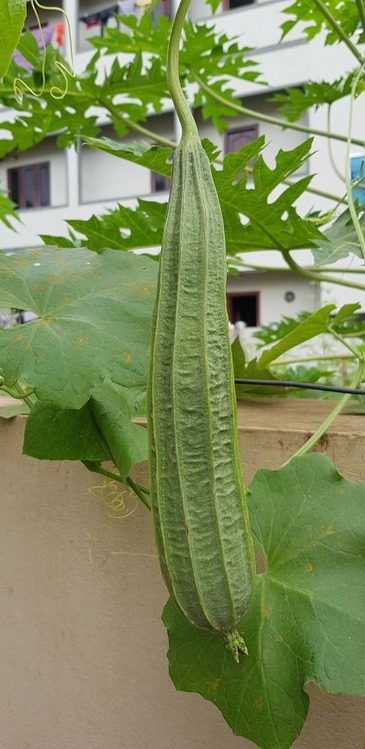If you’ve ever dreamed of growing your own garden curiosities or simply want to up your harvest game, the 8 easy-to-grow gourds are your go-to. From the elegant swan gourds to the ever-practical bottle gourds, each one has its own unique personality and purpose. Plus, they’re as low-maintenance as it gets—just plant, water, and watch them grow like crazy!
These gourds are like the quirky cousins of the pumpkin family, bringing a mix of funky shapes, vibrant colors, and tasty treats to your backyard. Whether you’re a gardening newbie or a seasoned green thumb, these gourds are the perfect way to show off your gardening prowess without breaking a sweat. Get ready to turn your garden into a vine-covered paradise, where every nook and cranny holds a delightful surprise.
1. Ash Gourd
 Image source: world-crops
Image source: world-crops
Ash Gourd is commonly known as winter melon, wax gourd, or white pumpkin. This vine plant is a warm-weather crop that grows well in tropical regions with temperatures between 77-85°F (25-30°C). Loamy and well-drained soil is one of the best choices for happy growth.
This vegetable is low in calories and carbs but high in fiber and antioxidants. Additionally, applying it topically can help reduce inflammation. Among edible gourds, ash gourd is one of the best. The white flesh of ash gourd is edible and has a pleasant taste. You can use it in pickles, stir-fries, and soups to enhance flavor.
2. Sponge Gourd or Luffa
 Image source: laidbackgardener
Image source: laidbackgardener
Luffas thrive in full sun and well-drained soil enriched with plenty of compost or well-rotted manure. It has two types of gourds that you can choose to grow in your garden including cylindrica (smooth) and aegyptiaca (ridged). The smooth luffa has small, rounded fruits, while the ridged luffa has larger fruits with long ridges. People often use both types interchangeably.
Luffa has a high water content, either boiled or in soups and stews. You can also stir-fry it with tomato gravy and garnish it with green chilies and fresh coriander.
3. Bottle Gourd
 Image source: veggiegardenseeds
Image source: veggiegardenseeds
Bottle Gourd also known as calabash or white-flowered gourd, this fruit comes in various shapes such as round, bottle-shaped, and slim. This gourd grows best in well-draining, moist soil in a warm, sunny spot and needs regular watering during the growing season. Although the vine needs a lot of space, you can grow it in large pots.
It has white flesh inside a smooth, green peel. Mild-flavored bottle gourd can be cooked as a vegetable after peeling off the thin skin and removing the seeds.
4. Bitter Gourd
 Image source: hudsonvalleyseed
Image source: hudsonvalleyseed
The Bitter Gourd has pointed ends and a thin layer of flesh that contains flat seeds. It’s best to harvest it while it’s still green, when the texture is watery and the flesh is crisp. This long, oval gourd begins to produce fruit about 3 to 4 months after planting.
You can grow the vine in hot, humid conditions, making it suitable for growing on terraces, balconies, or patios. When it is ready to be served, you can stir-fry it with a mix of flavorful spices and herbs. As its name implies, this gourd has a bitter taste, but its high nutritional value makes it special.
5. Snake Gourd
 Image source: sahajaseeds
Image source: sahajaseeds
Snake gourd is a fast-growing type of gourd, it needs to grow in warm, well-drained, and slightly acidic. When planting its seeds, make sure to space them 8-10 feet apart to avoid overcrowding
This tropical gourd is long and thin but is rich in essential vitamins and minerals. The leaves and shoots of the plant are both edible. It is often used in making tasty stews and flavorful pickles.
6. Pointed Gourd
 Image source: dezinebrainz
Image source: dezinebrainz
The perennial vine brings fruits, sometimes with white stripes, that are rich in fiber and vitamins. It thrives in a warm, and sunny spot with sandy loamy soil.
The fruit has crunchy seeds surrounded by soft flesh with a mild flavor. You can use it to make soups and stews or also stir-fried with a rich, thick gravy and served with steamed rice.
7. Apple Gourd
 Image source: organicbazar
Image source: organicbazar
Apple Gourd is also known as Indian squash or ‘tinda,’ it has a slightly thorny outer surface, similar to zucchini. Its crunchy texture pairs well with tomatoes, ginger, and chili gravy to make a spicy curry. This gourd is popular in Indian cooking and is often used in savory dishes.
This round apple gourd grows well in hot, humid climates, so protect it from frost. The vine begins to produce gourds within 60-70 days after planting. If you live in a colder area, growing them in pots is better.
8. Ridge Gourd
 Image source: google image
Image source: google image
As its name indicates, it has ridged and dark green, this gourd is part of the cucumber family and is high in dietary fiber. It also helps with digestion, improves vision, and supports weight loss. With many culinary uses, you can make a healthy curry by frying ridge gourd cubes with onions, tomatoes, chili powder, garlic, and salt.
For happy growth, be careful with watering—too much or too little can harm the plant. Use homemade compost as fertilizer.

